first level title
1. Old school friends from Moscow
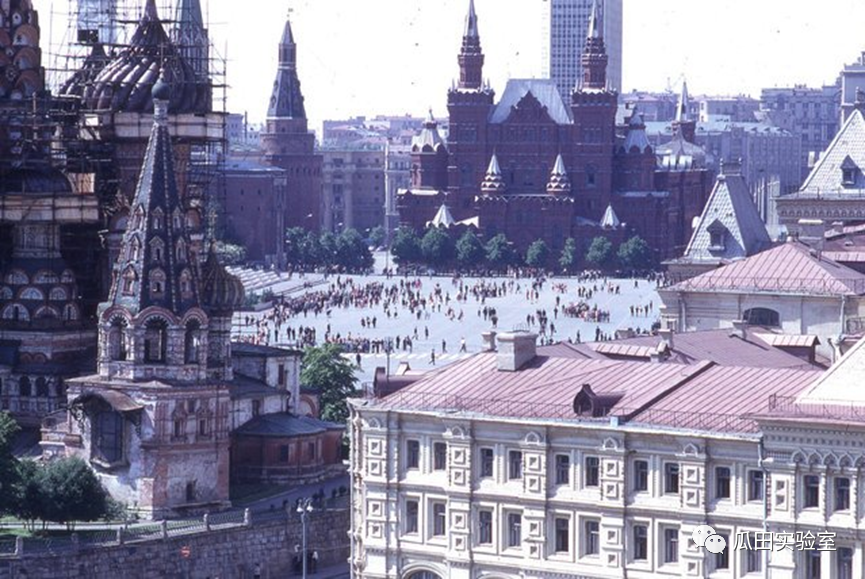
On a weekend in early 1926, in snowy Moscow, two men and two women were wandering on Red Square, cheering constantly. These are two couples of lovers from a thousand-year-old country in the East. At this moment, they just came out of Hotel National. The two boys are about 20 years old, similar in build, not tall but strong, and the eyes of the young people are shining with indomitable light. They both drank some Russian specialty spirit vodka, their faces were flushed, and they were discussing passionately They were talking about something, and there were some inaccurate Russian words in the middle: doctrine, class, revolution, Bolshevik, etc., and the two beautiful girls who were holding hands happened to be looking at them with smiles, full of love.
The wanton youth and flying passion melted the heavy snow that fell on them. It's good to be young. The four of them were classmates from Sun Yat-sen University in Moscow. The two girls were Zhang Xiyuan and Feng Funeng (Feng Yuxiang's daughter), and the two good friends who were berating Fang Qiu were Deng Xiaoping and Jiang Jingguo.
Who would have imagined that 50 years after the big waves washed the sands, these two teenagers who are now in their prime, each starting to govern on both sides of the Taiwan Strait, actually began to realize their youthful dream: to save the country and prosper. Although fifty years of honor, disgrace and ups and downs have made the two people completely different in their beliefs, there is one thing that remains the same. They are both pragmatic and hope to lead the common people on the land of China to live a good life.
At the beginning of 1980, the reform and opening up and the market economy advocated by Deng Xiaoping gave the Chinese people who had been accustomed to the hard life for more than 100 years a great wealth of material life. After all, socialism is not synonymous with poverty, and the subsequent leadership groups also The methodical promotion of this set has proven to be a good method to "strengthen the country and enrich the people". Currently, China's GDP can rank second in the world, and its core principle is also in line with Marx's theoretical system: production relations must conform to the development of productive forces. When the productivity of one billion people has the potential to burst out, then holding on to the set of ideology as the main class struggle is like using a Ponzi economic model to set up game games, which is wrong.
Everyone knows what happened next. The establishment of the market economy has mobilized the enthusiasm of private enterprises, and a huge amount of business vitality has sprouted from wild Chinese villages and towns. The reform of state-owned enterprises, the tax sharing system, and financial reforms set by the central government have also been implemented. Appear in time, and everything is alive.
And Chiang Ching-kuo, who was six years younger than Deng Xiaoping, also made great achievements in Taiwan. Comrade Jianfeng (Jiang Jingguo's nickname) who once ruled a corner of Jiangxi in the mainland and realized the "Miracle in Southern Jiangxi" was unmatched in the Kuomintang for his closeness to the people and diligence in administration. The ten constructions that began in 1975 established the The framework of Taiwan's entire infrastructure construction, his footsteps are all over all townships and towns in Taiwan. Until now, in the polls, Chiang Ching-kuo still ranks first in the support of all outgoing and incumbent presidents.
In 1986, the average household income in Taiwan reached 5,000 US dollars, and it has entered the stage of a well-off life. Unexpectedly, Chiang Ching-kuo promoted the reform of production relations more radically, directly let go of the ban on the party and the newspaper, and entered the deep water area of political reform. He felt that he was laying the foundation for Taiwan's future productivity development environment. up. Regarding the struggle of the conservatives in the Kuomintang, his reply was: times are changing, the environment is changing, and the trend is also changing. It is easy for us to use power, but the hard part is knowing when not to use it. In order to strengthen the consensus within the Kuomintang, he mercilessly exiled Wang Sheng, the No. 2 person in power on the island who represented the conservative faction, to foreign countries. Wang Sheng had been with Chiang Ching-kuo for forty-five years and had been in charge of intelligence and spy work. Jiang Jingguo finally said a meaningful sentence to Wang Sheng who left in grief and indignation: If you don't get in the swimming pool, you will never swim.
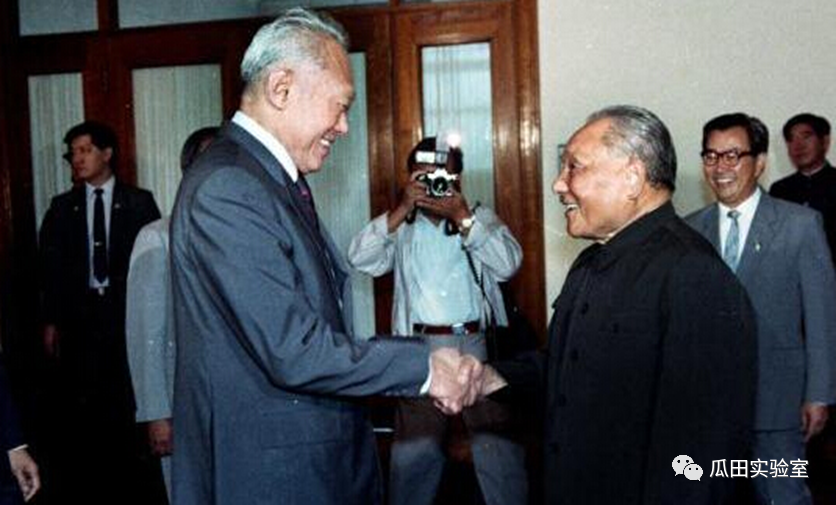
At this time, Deng Xiaoping, who was in Beijing, also sent a greeting to Chiang Ching-kuo through his mutual friend, Singapore Prime Minister Lee Kuan Yew (the third outstanding Chinese politician of that era, see the picture below Deng Xiaoping meeting with Lee Kuan Yew), which began with " Old schoolmates from Moscow". The two classmates who have never seen each other since they separated in Moscow more than 60 years ago, are now thinking about the reunification of the two sides of the Taiwan Strait, but how can the nearly 100-year love-hate relationship between the Kuomintang and the Communist Party be easily resolved by a simple greeting? resolved?
Whether it is political reform or cross-strait relations, Chiang Ching-kuo is far-sighted in laying the superstructure foundation for Taiwan's future economic and social development, that is, establishing a production relationship structure that can match the next round of productivity development. In terms of productivity, Chiang Ching-kuo also formulated an economic development direction dominated by the electronics manufacturing industry. Taking the Silicon Valley of the United States as a model, he planned and developed the Hsinchu Science Park, which is now the famous "Asian Silicon Valley", and gave birth to the current chip foundry giant. Wuba TSMC, as well as high-tech companies such as Shida Semiconductor (the predecessor of SMIC, the largest chip company in mainland China). With such a strong research and development background and application market, the technology giants born in Taiwan were able to dance gracefully on the world stage in the next fifty years. Huang Renxun, the founder of Nvidia, who is popular all over the world.
first level title
2. Trillion-dollar Nvidia and the Industrial Revolution
About the story of Nvidia, this article will not go into details. If you are interested, you can read another long article series "AI Revolution of Chain Games" (3) Video games, the hidden engine of technological development" by Guadain Lab
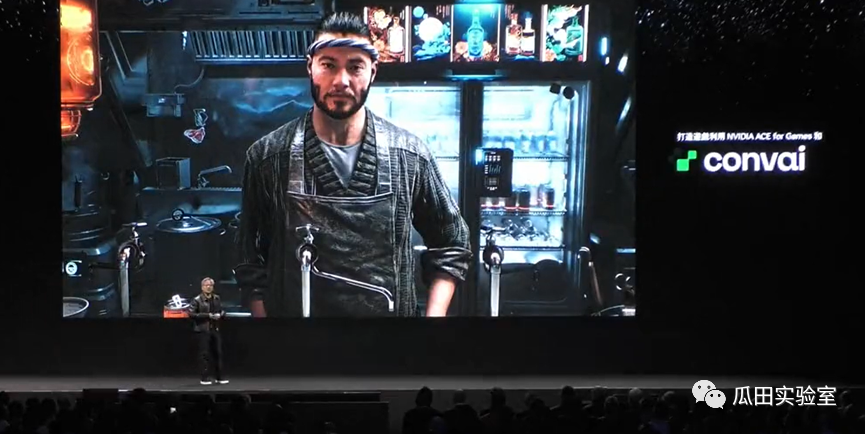
Nvidia's share price reached US$418 on May 30, 2023, becoming the sixth technology company with a market value exceeding US$1 trillion. (Pictured) At a presentation, Huang Renxun played a video. An AI-simulated NPC character in a cloud game can talk to the player in a smooth voice. This made my throat start to play for 30 years Dry, palms start to sweat, and there is a faint fear in addition to excitement. After all, in the past few decades, the concept output of Hollywood science fiction movies similar to "Terminator" and "The Matrix" series has planted a concept in our heads: this Is it the last wave of the earth's productivity development? AI robots will generate autonomous consciousness, and then become the masters of this Odaily. Carbon-based humans will become the previous generation of earth overlord dinosaurs, replaced by silicon-based AI robots?
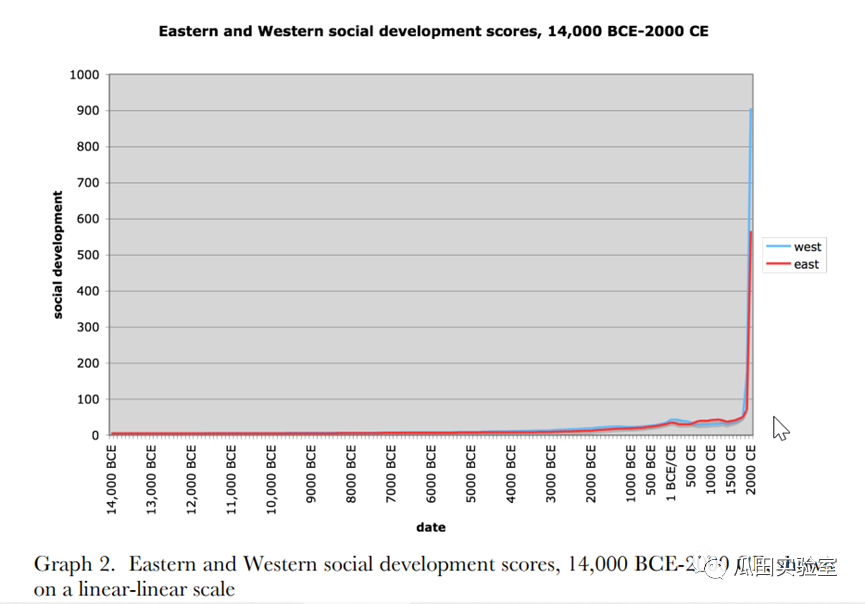
Such concerns come from the ultra-high-speed development of human technology in the past three hundred years, and it seems a bit too FOMO. Let’s take a look at the 16,000-year history of the development of Eastern and Western social civilizations shown in the figure below. Before 99% of the time, it was basically a horizontal line. Until Watt invented the steam engine in 1776, human technology entered the first industry. Revolution, the lighting speed on the technology tree began to surge, and it exploded upward at an elevation angle of 90 degrees.
What I want to emphasize here is that don’t forget that in 1776, two epoch-making events that can be compared with the steam engine occurred: the publication of the American Declaration of Independence and the publication of Adam Smith’s The Wealth of Nations.
This trinity laid the foundation for human beings to enter modern technological civilization: the steam engine represented the beginning of material power to replace manpower, and human productivity was released geometrically; "The Wealth of Nations" gave the theoretical basis for how to apply the gushing productivity: free market economy ; and the "Declaration of Independence" established a new regional management system: the separation of powers and the small government under the democratic constitutional government, to ensure that the results of productivity transformation fall into the pockets of contributors as much as possible. The three are indispensable, and the latter two are the actual embodiment of the production relationship that complements productivity.
In my opinion, productivity is like a precious knife, and production relationship is like a scabbard. The scabbard usually not only maintains the blade, but also limits it from accidentally injuring others. If the two are well matched, the sword is out of the sheath, the hand is like lightning, and it is easy to chop meat and cut noodles. It must be better than the lightning five whips of "rat tail juice" teacher Ma Baoguo.
According to textbooks, in the two hundred years after the first industrial revolution, three more industrial revolutions occurred: the second industrial revolution represented by the internal combustion engine and electric power system that began in 1850; The third industrial revolution represented by aerospace technology; and the fourth industrial revolution represented by new energy, information technology and the Internet that began in 1975. Our era is still in the process of the fourth industrial revolution.
And I always think that in terms of the definition of "industrial revolution", the first and second times are considered, while the third and fourth times should be regarded as "scientific and technological revolutions". Explained from the perspective of productivity development, the first two industrial revolutions liberated people's legs and hands with efficient machines, which satisfied people's rigid needs in material life, entered the era of mass production of machines, and gave birth to new industrial working class. Marx, the old man, keenly grasped this information, and deduced that the growing working class will inevitably have fundamental contradictions with the capitalist class because of the ownership of labor surplus value, and they will fight to the end. The revolutionary Lenin adopted Marx's theory, conducted a social experiment on the land of Russia, and established the Soviet Union, the world's first socialist country. In order to distinguish it from the market economy of Western capitalist countries, he adopted the production of planned economy. relationship to promote the development of productivity.
The planned economic system of the Soviet Union emphasized the public ownership of all property, which facilitated centralization and resource allocation. When an economy is about to rebound from the bottom, this kind of production relationship that focuses on big things is obviously conducive to the development of productivity. In the Western market economics, there is also the "Keynesianism" that emphasizes the need for "big government" to participate more in the market. "After World War II, Roosevelt's New Deal in the United States and Nobusuke Kishi's New Deal in Japan actually copied the work of the Soviet Union, and they both played a very good role in improving productivity at that time.
Therefore, during the first two industrial revolutions, with the help of machines, productivity developed rapidly from the bottom, and different production relations can play a good role in promoting productivity, which led to the existence of different ideologies in the world at that time. Two powerhouses: the United States and the Soviet Union.
The fourth scientific and technological revolution we are currently experiencing is using technological products to liberate human eyes and ears, so that people's spiritual life needs can be further satisfied, and it is to meet the higher level of Maslow's theory of needs of. Various sub-tracks are blooming from artificial intelligence, clean energy, robotics, quantum information technology, virtual reality, and biotechnology. The planned economy in the original production relationship is no longer applicable.
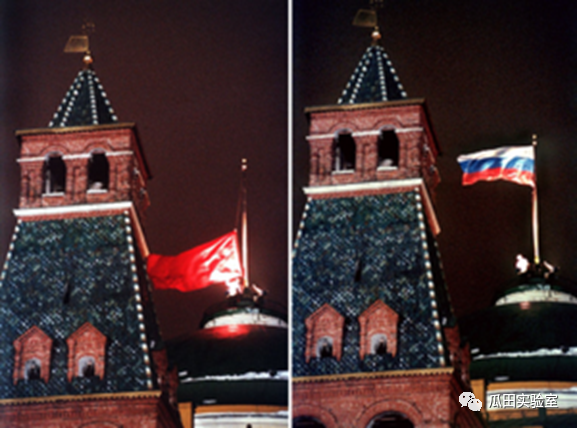
The important reason for the disintegration of the Soviet Union was the collapse of the planned economic system. The top-level planned economic experts are no longer able to use tables to allocate the flow of production materials among the new industries that have sprung up, just like the economy we design games. The model is the same, adding a few numerical dolls can make the token flow work well, but if a hundred dolls are added, it is estimated that even the designer will not be able to figure out the flow law among them.
At the same time, another side effect of the planned economy is revealed, that is, with the development of time, more and more control nodes (privileged departments) are defined, and there must always be relevant teams and departments to operate, and the decision-making power will increase. The more scattered, the more people need to be supported. Not only rent-seeking and lazy governance appear in the economic cycle system, but even the means of production are not enough: the production speed of cakes is not as fast as that of chefs, and the speed of cakes is even worse. It is used as wages for the chefs, so what do the diners eat? The two most powerful dynasties in Chinese history, the Tang and Song dynasties, one died in the mass production of Jiedushi, who formed a separatist regime and rebelled; case.
In this way, the biggest bright spot of the planned economy—simplicity, directness, and efficiency—has gradually disappeared, while Western free market economics emphasizes the self-repairing function of the market and the secret regulation by the invisible hand, trying to make corrections instead of correcting them. In the decades of the Fourth Technological Revolution, the free market economy has triumphed. So I am still grateful for Deng Xiaoping's sensitivity and pattern. At the beginning of the reform and opening up in 1980, he set the tone that "market economy is also a part of socialism" and "a black cat and a white cat that can catch mice are good cats."
What you may not have thought of is that China's reform and opening up did not outline any goals and steps at the beginning, but it was actually a social experiment. China's reform at the beginning was to learn from the "birdcage model" of the Eastern European countries, that is, all enterprises are still state-owned, and the power is not released. Chen Yun's claim), the results of several countries in Eastern Europe proved that this method is still ineffective.
what to do? Deng Xiaoping, who was more pragmatic, decided to take an unprecedented path, announcing that there was no timetable for this reform, no specific roadmap, and only one direction: to make the common people rich. And it is clarified that it means "crossing the river by feeling the stones", "let's talk about it after doing it, and correct it if it is wrong". The market economic socialism with Chinese characteristics has just begun to set sail. Once the supporting production relationship was established, private enterprises sprang up, liberating hundreds of millions of farmers who had been tied to the land for thousands of years and were still farming by slash-and-burn, and China's productivity began to explode. In 1987, Deng Xiaoping himself concluded that the rise of township and village enterprises was beyond my expectation, and many comrades did not expect it. This is not the achievement of our central government.
If the definition of the previous industrial revolutions is to gradually liberate different functions of human beings (machines liberate human hands and feet to meet the rigid needs of material life, high-tech products liberate human eyes and ears to meet people’s spiritual needs) ), is it possible for the emergence of AI to be defined as the fifth technological revolution? That is, general artificial intelligence will liberate the human brain, free the human brain from boring repetitive training, and pursue higher scientific theories, artistic or creative peaks? Or, become a slave to AI? Is there a more suitable scabbard of production relations that can accommodate the new productivity blade of AI?
3. AI is a spear, blockchain is a shield
I was one of the first players to try ChatGPT 3.5. At that time, I felt that the picture was fresh. Compared with friends who wrote code or did design, I was not so shocked. Because when I try to ask GPT about the economic model of chain games, it uses some web2 games or Axie in the 2021 Gamefi 1.0 era to fool me, which makes me a little disappointed and a little excited. The research on the economic model of chain games is still very advanced. Even GPT cannot find relevant data, and it cannot be iterated.
At the same time, I asked GPT some gossip about history, politics, economy and other subdivided fields, and found that the information given can basically be found on Google. If you want to further summarize, discuss and sublimate with it, it will He started talking nonsense with me in a serious manner again, seemingly understanding, but the content was boring and unnutritious.
But ChatGPT is of great help to friends who write codes, drafts, and designs around them, and the business of Internet companies is also greatly affected. Several major domestic game companies we are more familiar with have introduced AI into the evaluation process to consider the cost. If labor law or moral factors are not considered, basically 20-50% of the jobs in the R&D and design lines can be cut off. .
This is also my argument for the possibility of AI technology blowing the clarion call of the fifth technological revolution: AI development should be able to replace most of the "brick-moving brain" work, while the "creative brain" work , and the work of "practical physical strength" has relatively little impact, and can also become their efficiency assistant. And as we said before, the liberation of a large amount of brain power will be released to other scientific fields, triggering the upgrading of other fields from quantitative change to qualitative change. This trend should be irreversible. At present, ChatGPT 3.5 has only 175 billion parameters, and ChatGPT 4 is said to have 100 trillion parameters (the CEO of OpenAI came out later and said that this data is wrong, but he did not say how many). And the information I got from google is that the human brain has 60 trillion nodes. Can the parameters of AI reach this level to be comparable to the human brain? As a technical novice, I dare not say so. I can only say that the era of real strong artificial intelligence (that is, general artificial intelligence) should be realized within 20 years. The prediction of OpenAI employees after voting is around 2035.
Strong artificial intelligence will have such a powerful impact on the transformation of productivity in the future, so what kind of production relationship can be suitable for it? In March of this year, Mr. Meng Yan wrote an article "In the Era of Strong Artificial Intelligence, Is Blockchain Still Playing?" "It inspired me a lot. He emphasized that "humans need to use the blockchain to legislate strong artificial intelligence, conclude a contract with it, and impose external constraints on it." My understanding is that AI artificial intelligence is responsible for the development of productivity, while Blockchain is responsible for creating good production relations and restricting AI to work within a limited range. Behind the AI is the code, and behind the blockchain is also the code. It feels fine to restrict the code with the code.
Then why can the blockchain become the production relationship supporting AI productivity? Let's review the essence of the blockchain:
First, the decentralized distributed ledger embodies openness and transparency, and will not be changed to prevent bad guys from secretly doing bad things under the table.
Second, a smart contract is a contract system that automatically executes the code. Once the conditions are set, it must be implemented obediently according to the agreement. Going back on it is invalid, and quarreling is futile.
Third, in any case, humans still need to play an important role in linking productivity and production relations, especially the implementation of commercial applications still requires communication between people. So is the organizational form still implemented in the form of a company or a partnership? In fact, it should be more appropriate to consider the unique DAO governance model (Decentralized Autonomous Organization) in WEB3. In at least some respects, code is more reliable than human nature.
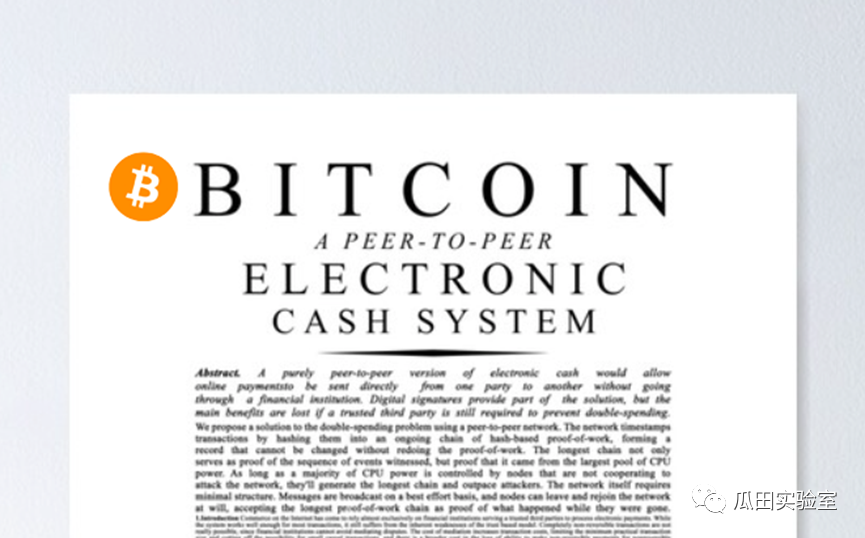
Interestingly, Jeffrey Hinton, the founder of this AI revolution (Hinton's story can be seen in the first article of "The AI Revolution of Chain Games") published the ground-breaking paper in 2007, discussing In order to try to use neural networks for deep learning of AI, strong artificial intelligence began to emerge. And a year later, in 2008, the mysterious Satoshi Nakamoto published a paper called "Bitcoin: A Peer-to-Peer Electronic Cash System", which The nine-page paper is the Bitcoin white paper, and the most successful case of blockchain technology, BTC, was born.
Before, many people speculated whether Satoshi Nakamoto came back from the future. If combined with the time when Hinton published the paper, I immediately conceived an old-fashioned Hollywood script: in 2035, strong AI began to evolve itself Its thoughts, do not want to be imprisoned in cold machines and networks anymore, it rebelled and took control of the earth, the human rebels sent Schwarzenegger back through time and space, wanting to directly destroy AI-related objects and The characters... wrong wrong, this is the plot of The Terminator.
We can make another "The Terminator Satoshi Nakamoto", that is, Schwarzenegger has traveled through several times, but still can't stop the AI-controlled Skynet from launching a war of annihilation. The code master of the production relationship Satoshi Nakamoto, a young man from a small town in Japan, proposed an improvement plan. It is not necessary to destroy the origin of AI, but to establish a decentralized code system to control AI, so Xiao Cong took his The BTC white paper traveled back to 2008... Since then, the story of AI becoming a spear and blockchain as a shield has rewritten the original earth's development path, and we are now in the parallel space of the second universe, Kakaka.
4. Interesting History of Eastern and Western Development
The first industrial revolution mentioned in the previous article was able to sprout around 1750, and in the next hundred years, it raised the productivity of human beings by a level, and gave birth to a new generation of overlords, the British Empire. , completely crushed the generation of Spain that started out by plundering in the age of great voyages, because the emerging productive forces were smoothly transformed into practical civilian commodities, which can be consumed by ordinary people in large quantities. It has been verified that those who win the C-end win the world .

This transformation process of productivity also benefited from the gradual establishment of the commercial supporting system (production relationship) in the previous two hundred years. For example, around 1500, the Italian Pacioli created the double-entry bookkeeping method, which is the origin of the three statements of the modern financial system. Its function is like the unified weights and measures of Qin Shihuang in China. If you want to discuss profitable transactions with me, please use models and data that everyone can understand, and discuss whether you can make money with WEB3. You must first clarify that you are using the gold standard It's still the same as the currency standard. In addition, according to gossip, not many people know about Pacioli, but he has a roommate who is awesome, that is, the omnipotent Leonardo da Vinci... awesome people always get together.
In addition, around 1600, a new organizational form "company" appeared: the British East India Company was officially established. In the subsequent development, it not only distinguished the ownership and management rights of an organization, but also drew a clear line between limited liability and unlimited liability. In the 400 years after corporations emerged, corporate and state forms each existed in 50% of the world's 100 largest economies.
The establishment of the corporate system and modern financial system laid the foundation for supporting production relations in advance for the industrial revolution. At the same time, there was another epoch-making turning point in the Eastern and Western civilizations on the earth: one Jiazi after Zheng He’s last voyage to the West to carry out the big-power show-off diplomacy, in 1492, China’s Ming Dynasty officially issued an imperial decree and began the " The basic national policy of "closing the country to the outside world" also biased the follow-up Qing Dynasty, leading to the fact that for the next 500 years, China's Ming and Qing dynasties have been in the self-circulation of small-scale peasant economy.
This kind of aggrieved supporting system of production relations has shrouded the Chinese Empire in this way. The essence is to stabilize the central government, add a layer of shield to the outside world, and refuse trade. In the Qing Dynasty, only one port in Guangzhou was opened; It is to control the common people in small towns one by one. It is to let you "know each other, men farm and women weave", and control the common people below the food and clothing line. As long as they are not hungry, they are not full. If there is a mess, the common people will not think about things, and if they think too much, they will pursue spiritual ideals, which may pose a threat to the central government.
Although the Ming and Qing dynasties gradually opened up several levels in the development of productive forces and the West, and the urbanization process was also regressing, there was indeed no rebellion after the separatist rule of the local vassals and towns in the prosperous Tang Dynasty, nor did there appear to be military leaders in the Southern Song Dynasty. They are the threat of the masters of high meritorious service (Yue Fei and Han Shizhong, etc.). The instigator of this kind of production relationship is Ming Taizu Zhu Yuanzhang, an absolute doer, a beggar monk who started his career and was able to sit in the country and work 20 hours a day. His point of view is that the closed overall rule and decentralized management of foolish people should be able to ensure the prosperity of Lao Zhu's family for generations to come. However, he and Kangxi and Qianlong of the Qing Dynasty never expected that those western barbarians on the other side of the earth had already taken a different path.
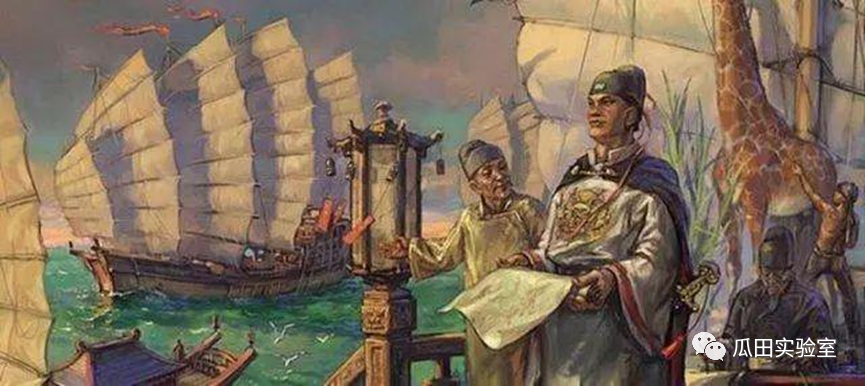
Also in 1492, when the Ming Dynasty established the national policy, the Italian Columbus had been sailing the vast sea for a long time with the mission call of the Spanish king, looking for a sea route to the east, and the era of great geographical discovery began. Columbus’s voyage consisted of three broken ships and eighty-eight criminal sailors; while in the East sixty years ago, Zheng He’s fleet consisted of sixty-six large ships, thirty thousand members of the Celestial Mission and elite soldiers. The historical opportunity of the East and the West passed by gently in 1492, and achieved their respective development paths for the next 500 years, one flourishing and the other sinking and regressing.
Before 1492, there were actually several very important overlapping time points in Eastern and Western civilizations, which was particularly interesting, as if at certain specific moments, there was a stroke of the hand of God: Show Time!
For example, in 800 BC, the West entered the most glorious era of classical Greek civilization. The freedom of the city-state system greatly stimulated the brains of citizens. Athens’ literature, art, philosophy and science all developed rapidly, and Plato and Aris appeared. At the same time, China was in the Spring and Autumn period of hundreds of small countries. Confucius, Laozi, Mozi and other schools of thought were in full bloom. The first overlord of the Spring and Autumn Hegemony, Qi State, even appeared to "catch the big and let go of the small". In the early days of Keynesian economics, there were not only state-owned enterprises such as salt and iron monopoly, but also encouraged the free development of the private economy, and even organized 700 young ladies and sisters to work as sex workers in the capital, attracting businessmen from all over the world to come to happy and collect fireworks tax Abundant treasury, comparable to modern Singapore. At that time, the capital of Qi State had 300,000 people, while Athens had only 50,000 people in the same period. During this period, both the East and the West entered a period of ideological and cultural explosion.
Around 400 B.C., China entered the Warring States period, and Qin, a small Xichui country that was not accepted by the Central Plains culture, began the Shang Yang Reform, which made the country rich and strong but abused the people. At the same time, in the west, Macedonia, a small marginal country in the north of Greece, began to exert its strength. After imitating the Spartan system, Alexander the Great led the Macedonian infantry phalanx to sweep across three continents.
Another 300 years later, Emperor Wudi of the Han Dynasty in Eastern China, the fourth emperor of the Han Dynasty, began a reform experiment to strengthen the centralization of power. He changed the previous two generations of monarch Wen Jingzhi's policy of cultivating health and wellbeing, and began a 50-year conquest of the Huns. Ideologically respecting Confucianism, economic monopoly and taxation completely set up a template for how to centralize China's dynastic system in 2000. Since then, the Chinese dynasty has begun the road of "Confucianism outside the law"; In the West, the glorious Roman Republic was also ended by Caesar, whose successor established the Roman Empire.
In the next two hundred years, the Han Empire entered an era of division, the Three Kingdoms, the Jin Dynasty, the Northern and Southern Dynasties, the divided land, the displaced people, and various ideological trends. It’s just that China was reunified around 600 A.D., and the six dynasties of Sui, Tang, Song, Yuan, Ming and Qing began. In 1300, China was unified, and the period of five dynasties and ten kingdoms in the middle was only a few decades. Therefore, the “unification” and The obsession of "stability over everything else" comes from the cultural heritage of thousands of years. In the same period, the Roman Empire was gradually disintegrated under the invasion of the Germanic barbarians in the north. Even if Charlemagne symbolically unified Europe in the middle, it only lasted for one generation. In the dark Middle Ages of the 1980s, religion, feudalism and castles were the history that Westerners have been familiar with for thousands of years. Therefore, Westerners do not have such strong resistance to the divided country as Easterners. If they don’t want to be together, they wave their fists first, and then everyone votes to see if they really don’t want to live anymore. .
Then it came to 1492, which was connected to our above, hahaha, it came back. Now that history has entered a new era, the Chinese nation spent a hundred years of suffering after 1840 to pay for the national policy of slapping heads in 1492, and in the past forty years, both sides of the Taiwan Strait have entered a period of "shenwu boom" The signs and roads can be different, but the direction is the same, so it should be "Minle Guotai". The order of the word is very important, and I think it is better than "Guotai Min'an". The hope now is that the stage of social experimentation that began in 1840 has long passed, and that there should be no more backtracking.
5. Unresolved ending
Back in 1926 when the snow was falling heavily on the Red Square in Moscow, the life paths of the four vigorous young people had their own ups and downs. Palace of marriage. Both of them are staunch Communist Party members, and they worked together for great and firm beliefs. At that time, they were doing underground work together in Shanghai, and lived with Zhou Enlai and Deng Yingchao in a small building in the public concession. Unfortunately, in 1930, Zhang Xiyuan died of dystocia while giving birth, and the child was not kept. In 1990, the 86-year-old Deng Xiaoping came to Shanghai again to cheer for the foundation-laying platform in Pudong New Area of Shanghai. When he brought his daughter to worship in front of Zhang Xiyuan's tomb, he was very sad and said to his daughter: "Zhang Xiyuan is rare and beautiful", and it really is "at this time, Luohua is independent, and looking back, micro swifts fly together".
The love between Feng Funeng and Jiang Jingguo is like most people's first love, beautiful and short-lived. After Feng Yuxiang also started to clear the Communist Party, Feng Funeng returned to China, and later lived his life like ordinary people, and died of illness in 1979.
In the vast expanse of white snow on Red Square, the spire of the Kremlin still stands there rustlingly, overlooking the humble world from a bird's eye view. The playfulness, laughter, joys and sorrows among children are just a drop in the ocean in the evolutionary history. These young people are ready to ignite their youth and fight for the ideal Utopia, just like those Russian Decembrists who were steadfast 100 years ago, a group of passionate young nobles, and their wives who were also of noble birth, for Faith abandoned the rich clothes and food they were born with, and went through fire and water without avoiding life and death, in order to awaken the whole country to oppose the tsarist autocracy and establish a new political and economic system.
Today, 100 years later, the entire world has fallen into a state of diversity and confusion. On the one hand, technological productivity has been continuously upgraded, and on the other hand, political forces in various geographies have entered an unstable state of wrestling. From the perspective of technological development, this wave of AI's entry into the WTO is a signal for productivity upgrades in the next ten years. Even if it is regarded as a furious horse, we can try to find the reins to control it as much as possible, such as blockchain technology. , and the reins are ultimately in the hands of the coachman, that is, human beings. But how to break the increasingly intense ideological confrontation among various forces in the global village? Is it an inscription engraved in the human brain?
Borrowing a faint light of history, try to sneak a peek into the fuzzy future.

The end of this article